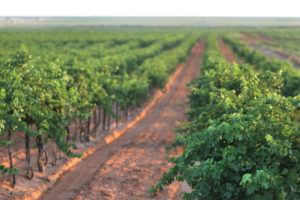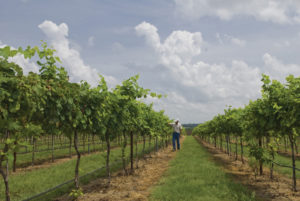Photos courtesy of Texas Department of Agriculture / Go Texan
Tip your glasses and make a toast to Texas Hill Country’s 62 wineries and vineyards. They attract more visitors to the area from north of Frederick to San Saba, and west to Menard than any other.
In about 1659, Franciscan priests established the first North American vineyard in Texas. European settlers followed suit with the development of mission outposts, bringing more grapevine cuttings and further developing vineyards through the 1800s.
Through trial and error, Texas grape growers learned what varieties do well in Texas climate and soil and take pride in sharing award-winning Texas wines made with Texas grapes. According to www.txwines.org, 38 varieties of Texas wine exist.
Overall, records show that the Texas wine and wine grape industry contributes more than $13.1 billion of economic value to Texas; 104,267 full-time jobs paying $4.3 billion in wages; 1.7 million tourist visits to Texas wineries, spending $716.6 million, and 436 wineries.
Texas has eight officially recognized wine growing regions known as American Viticulturist Areas (AVA). Climate, soils, and topography are considered in characterizing wine growing regions.
Before refrigeration, grape growing was believed to be more conducive to cold climates because you had cooler fermentation. However, with refrigeration, fermentation can be controlled everywhere, including Texas.
Winemakers of a young 35-40-year-old Texas wine industry are still experimenting with which grapes will grow in Texas. Fortunately, hot summers and cold winters allow their grapes to achieve full ripeness, excellent skin color, and rich concentrated flavors. Texas Hill Country winemakers show great success with Tempranillo, a common Spanish variety. (Texas Tempranillo is amazing.) Grenache, Syrah, Mourvedre, and Viognier are also popular Texas varietals.
Whether you visit Texas Hill Country wineries on your own or with a tour group, it’s a fun/educational trip. If you choose a self-guided tour, it’s wise to choose a designated driver; however, it comes with a lot of advantages. It’s more affordable and gives more flexibility. Check for hours of operation, distance from one winery to another, and where you can stop for lunch.


Happy wine tasting.
The Guadalupe Wine Trail
A fairly small wine trail with six boutique wineries, but with expected growth over the next few years. The boutique wineries are: Singing Water Vineyards, Kerrville Hills Winery, Dry Comal Creek, The Chisholm Trail Winery, Sister Creek Vineyards, and Bending Branch Winery.
The Colorado River Wine Trail
This trail starts just north of Marble Falls and heads into Burnet, Lam passes, and San Saba, ending at Lake Buchanan. Just as with the Guadalupe Wine Trail, there are a few family-owned boutique wineries. They include Flat Creek Estate, Perissos, Texas Legato Winery, Lorneta and Fiests Winery, Alamosa Wine Cellars, Wedding Oak Winery, and Fall Creek Vineyards.
Texas Hills Vineyard
You will find welcoming grounds, a tasting room with excellent 100 percent Texas wines, and a knowledgeable staff. It is the largest Texas producer that uses 100 percent Texas fruit with an Italian influence. Sangiovese is a specialty. It is located one mile east of Johnson City on Ranch Road 2766, the road to Pedernales Falls State Park.
William Chris Vineyards
Family owned, topnotch, boutique winery that specializes in 100 percent Texas wines. Owners/winemakers Bill Blackmon and Chris Brundrett grew grapes and made wine for other companies until 2008 when they started William Chris Vineyards. The small tasting room was formerly a small barn, which was remodeled to a new, open tasting room with wonderful views overlooking the outside seating area and vineyard. An attendant outside the tasting room welcomes you as you leave the parking area and helps space people at the tasting bar to prevent overcrowding inside. William Chris Vineyards are located at 10352 U.S. Hwy. 290, Hye, Texas 78635.
Pedernales Cellars
A boutique winery that produces 100 percent Texas wines, Pedernales Cellars offers two tasting options. The first tasting – general wines; the second offering – reserve wines. Reserve wines feature the opportunity to taste wines exclusively available to wine club members – library wines, estate blends, and older vintages. The geothermal barrel cellar can be toured free of charge on Saturdays and Sundays. Breathtaking views of the Pedernales River valley can be seen from a huge, tree-covered deck. Pedernales Cellars is located at 2916 Upper Albert Road, Stonewall, Texas 78671.
Becker Vineyards
In 1993, Mr. and Mrs. Becker planted their first grape vines, hoping to create a 1,500-case winery in the Texas Hill Country. Today, it’s a 100,000-case per year winery that has received numerous awards. Weekends are often standing room only, but large indoor and outdoor spaces provide numerous tasting stations. An onsite restaurant satisfies your taste buds and multiple tables with covered seating area throughout the grounds provide restful/sociable qualities. You can find these niceties at 464 Becker Farms Road, Stonewall, Texas 78671.
Messina Hof
As a result of producing wonderful wines, Messina Hof, is the most awarded winery in the Southwest. Presently, 28 vineyards, 1,050 acres produce more than 85 wines from 27 varietals. Paul Bonarrigo and wife Merrill produced their first vintage in 1983. Paul is the first-born son in a family that has been making wine outside Messina, Sicily since 1800. A first generation Italian-American, he studied and practiced physical therapy, but wine was in his blood. When he moved his practice to Bryan, Texas, he teamed up with Ron Perry and planted 13 vineyards all over Texas with 50 varietals to see where certain varietals should be grown. The tasting room, restaurant, and Manor Haus B&B at the Fredericksburg location is a must-see if you are in the Texas Hill Country, but there are two additional tasting rooms you can sample Messina Hof wines in Grapevine and Bryan.



Hi, this is a comment.
To get started with moderating, editing, and deleting comments, please visit the Comments screen in the dashboard.
Commenter avatars come from Gravatar.